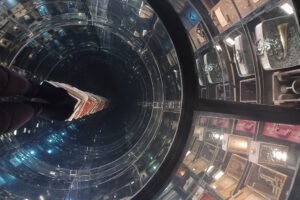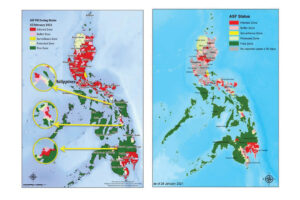Into the abyss of history and wonder

ARTIST Mark Justiniani’s latest installation exhibition, called “Void of Spectacles,” challenges the audience to venture over vast, daunting, mirrored spaces.
There, beyond the illusion of falling into a void, a confrontation with Filipino identity and memory takes place.
The art is experiential, accommodating only one person at a time to step onto a three-dimensional box of mirrors. While it may be terrifying for those with a fear of heights, the glass floor is strong and stable, keeping one away from the trick of light mimicking a free fall below.
For Mr. Justiniani, mounting the three large installations — Firewalk, Arkipelago, and Well — may have been a massive, complex task, but it was a must for him to bring them all home after their respective journeys abroad and retouch them a bit for Filipinos to see.
“One of the takeaways that I want the audience to carry the question is, what is in the void? What is there in the void? Is it really nothing? It seems thicker than nothing; in fact, it feels that there’s something there,” he told BusinessWorld at the media preview early in February.
Adding to the concept is the second word in the exhibit’s title, “spectacles,” implying something excessive, a “lens that is too superficial to perceive as reality.”
The exhibit is at the Ateneo Art Gallery’s third floor, and visitors are provided with non-slip socks or shoe covers to stand directly on the installations’ tempered glass surfaces. Underneath the glass, mirrors create an illusion in which the real-world objects inside look as if they are adorning the walls of a never-ending abyss.
The artist explained: “I wanted people to realize that the sense of sight is very limited. We operate in a world that is so limited that we claim to know truths even though we don’t really see truths.”
Ateneo Art Gallery director and chief curator Boots Herrera added that it was the most challenging exhibit they had ever put up, taking almost two months to load everything into the building and then carefully reconstruct it.
Co-presented with the Tungtung Alon Art Foundation, it marks the very first time all three infinity installations are exhibited in the Philippines.
“Mark’s social realist roots are still present but presented in a subtle way. It helps to have a sense of Philippine history and the artist himself,” Ms. Herrera said. “Sparking a conversation [about the work] would be nice.”
It starts off with Firewalk, a 53-foot-long box of mirrors that was initially shown at the Gallery Children’s Biennale in the National Gallery Singapore from 2017 to 2021. It looks similar to an archeological dig site, complete with niches filled with artifacts like toys, papers, and long piles of books.
The main section is the Arkipelago trilogy, divided into three boxes. The first is Province, an ode to Philippine provincial life and specific to Mr. Justiniani’s upbringing in Negros, as seen in sugar train parts and small meal portions on banana leaves juxtaposed with detailed pillars of hacienda homes.
“It can be specific and general at the same time… Sugar trains are specific to Negros island, but now they don’t exist and are just a part of our sweeping collective memory,” he said.
Capital, the second segment of the trilogy, reflects life in the big city. It contains wine glasses, piano keys, table cloths, school medals, and guns, with a tower of drawers filled with papers representing bureaucracy.
In the final part, Cyclone, Mr. Justiniani depicts man’s limited time on earth through natural resources like grass, soil, crops, and bamboo, and manmade textures like concrete and metal. Here, the mirrors bend to give the illusion that these materials in the void warp in a curve beneath.
The three parts of Arkipelago were exhibited in one hall at the Philippine Pavilion at the 58th Venice Biennale in Italy in 2019. At Ateneo, they are split in different areas of the exhibit space.
“It was difficult to find a space for the whole collection. It’s more intimate here because you isolate each segment, giving it a different feel,” said the artist.
The third and final installation, Well, is the least dizzying, almost providing a sense of relief in its portrayal of the transitory nature of life. While still made mind-boggling with mirrors, its depths are not terrifying and its walls are lined with little trinkets and keepsakes that humans like to possess.
Mr. Justiniani is aware that the work can be seen as “a bit of a spectacle” — it is in the name, after all.
“It can actually be criticized that way if you don’t look at it closely. It’s up to the audience to say or judge if it is superficial … I’m just thankful I encountered this medium. I’m not the first one who did this and there have been many other ‘infinitors.’ People can say what they want,” he said.
Set up at the third floor of Ateneo Art Gallery, the exhibit is a proud accomplishment of trial and error. “More than 90% of the changes I made from their runs abroad are mistakes that led to ideas,” said its creator.
He hopes that his countrymen will be willing to explore the stories placed within the walls of the works and reflect on their own memories.
“Void of Spectacles” is on display at the Ateneo Art Gallery until July 6. Admission is P50. — Brontë H. Lacsamana




